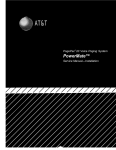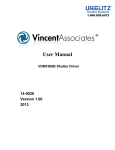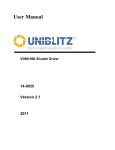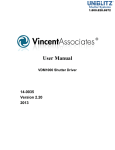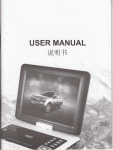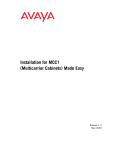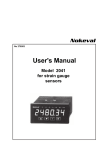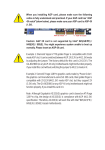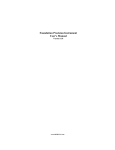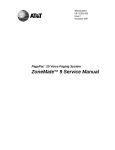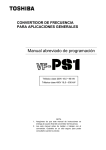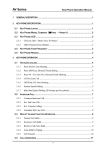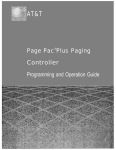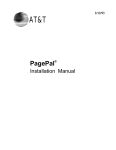Download PagePac VS Service Manual Installation
Transcript
AT&T SERVICE MANUAL PagePac® VS (AT&T VERSION) INSTALLATION AT&T SERVICE MANUAL PagePac* VS INSTALLATION SM–722994–004 Issue 1, February 1984 *Registered Trademark of Harris Corporation Dracon Division Copyright ©HARRIS CORPORATION 1984. Table of Contents Service Manual Page i February 1984 Table of Contents 1. Introduction Page 1-1 Overview 1-1 System Components 1-1 Power Requirements 1-2 Environmental Requirements 1-2 Functional Description Connectors Switches and Controls 1-2 1-2 1-6 2. Installation 2-1 Overview 2-1 Unpacking Instructions 2-1 Mounting Site Selection 2-2 To Mount the Unit 2-3 Installation of Optional Circuit Cards FM Tuner Card Talk-Back Control Card 2-3 2-3 2-5 Connections to CPE Music Card 2-7 Connections to Terminal Block TB1 Ground Wire Connection Loudspeaker Connection Music-On-Hold Connection External FM Antenna Connection Off-Premises or Remote Amplifier Connection 2-7 2-7 2-7 2-8 2-8 2-8 PagePac VS to Host Telephone System Connection COM KEY* 416 System Connections Horizon* Connections Dimension* Connections 2-9 2-9 2-13 2-15 *Registered Trademark of AT&T Service Manual Table of Contents/List of Figures February 1984 Page ii Table of Contents (Cont’d.) 2. Installation (Cont’d.) System Power-Up and FM Tuner Card Adjustment System Power-Up FM Tuner Card Adjustment and Controls FM Tuner Card Station Selection FM Tuner Card Music-On-Hold Volume Adjustment 3. System Operation and Test Page 2-17 2-17 2-17 2-17 2-18 3-1 Overview 3-1 Com-Key 416 Operation and Test Zone Selection by DSS Buttons Dial Zone Selection 3-2 3-2 3-2 Horizon Operation and Test 3-3 Dimension Operation and Test 3-4 Talk-Back Test 3-5 FM Background Music Test 3-5 4-1 4. Maintenance 4-1 Overview List of Figures 1-1 1-2 1-3 1-4 2-1 2-2 2-3 2-4 PagePac VS PagePac VS Connectors, Switches, and Controls (Cover Removed) CPE Music Card Installed Terminal Block TB1 Removing PagePac VS Cover PagePac VS Mounting Space Requirements Opening PagePac VS Talk-Back/FM Tuner Card Protective Cover Installation of Optional Circuit Cards 1-1 1-3 1-4 1-4 2-1 2-2 2-4 2-4 List of Figures/Tables Service Manual Page iii February 1984 List of Figures (Cont’d.) 2-5 2-6 2-7 2-8 2-9 2-10 Talk-Back Option Strap Locations FM Antenna Cable Connection to Com Key System Cable Connection to HORIZON CS System Cable Connection to DIMENSION System FM Tuner Card Controls and Indicator Page 2-6 2-9 2-12 2-14 2-16 2-19 List of Tables 1-A 1-B 2-A 2-B 2-C 2-D 4-A Terminal Block TB1 Connections PagePac VS Switch Functions Talk-Back Control Card Options PagePac VS lnitial Setup PagePac VS Com Key Connector Pinouts FM Tuner Card Controls and Indicator Trouble Analysis 1-5 1-6 2-6 2-11 2-12 2-20 4-1 Service Manual February 1984 FCC Registration Page A Federal Communication Commission (FCC) Registration Compliance In compliance with Part 68 of the FCC Rules and Regulations, the customer is advised as follows: Standard Plugs and Jacks Direct connection to the network must be through a USOC-type jack. Registered terminal equipment or protective circuitry may not be used with party lines or coin telephone lines. Notification to Telephone Company Customers connecting terminal equipment to the telephone network shall, before such connection is made, give notice to the telephone company of the particular line(s) to which such connection is to be made and shall provide to the telephone company the FCC registration number and the ringer equivalence of the registered protective circuitry. Notice of final disconnect shall also be given. Separate Wiring Compliance with FCC Registration requires that wiring between PagePac VS and the loudspeakers be in a cable harness separate from all other leads. It is also a requirement that the PagePac VS be installed by a trained and authorized agent of the manufacturer or under the supervision of a licensed professional engineer, as provided for in section 68.215 of the FCC Rules and Regulations. Separate Housing The PagePac VS has its own housing and mounts externally to the associated telephone system. Incident of Harm Should terminal equipment cause harm to the telephone network, the telephone company shall, where practicable, notify the customer that temporary discontinuance of service may be required. However, where prior notice is not practicable, the telephone company may temporarily disconnect service forthwith, if such action is reasonable in the circumstances. In case of temporary discontinuance, the telephone company shall (1) promptly notify the customer of such temporary discontinuance, (2) afford the customer the opportunity to correct the situation which gave rise to the temporary discontinuance, and (3) inform the customer of his right to bring a complaint to the Commission pursuant to the procedure set out in Subpart E of Part 68. FCC Registration Service Manual February 1984 Page B Changes in Telephone Company Facilities, Equipment, Operations or Procedures The telephone company may make changes in its communications facilities, equipment, operations or procedures, when such action is reasonably required in the operation of its business and is not inconsistent with the rules and regulations of Part 68. If such changes can be reasonably expected to render any customer’s terminal equipment incompatible with the telephone company communications facilities, or require modification or alteration of such terminal equipment, or otherwise materially affect its use or performance, the customer shall be given adequate notice in writing, to allow the customer an opportunity to maintain uninterrupted service. Repairs Repair of registered terminal equipment and registered protective circuitry shall be accomplished only by the manufacturer or by its authorized agent. This applies at any time during and after the warranty period. Equipment Malfunctions When trouble is experienced, the customer shall disconnect the registered equipment from the telephone line to determine if the registered equipment is malfunctioning, and that, if the registered equipment is malfunctioning, the use of such equipment shall be discontinued until the problem has been corrected. Registration Number The type of connecting arrangement (jack) to be ordered from the telephone company is indicated below as typical. Other standard jacks may be used for specific applications. ● Typical Connecting Jack: USOC RJ-18C ● FCC Registration Number: APF9Q9-70328-OT-N ● Ringer Equivalence: 0.8B Introduction Service Manual Page 1-1 February 1984 1. Introduction Overview This service manual contains installation, test and maintenance procedures for PagePac VS, a 35-watt zone paging unit designed to operate with most telephone systems. Connection instructions for compatible host systems are contained in Section 2. PagePac VS provides up to three separate paging zones (zone paging) and all call paging (paging into all zones at once). Audio output to the paging loudspeakers can be set at either 70.7 or 25 volts AC. Three optional features, Talk-Back, FM background music, and Music-On-Hold, are also available. Operating instructions for the various telephone systems to which PagePac VS may be connected, as well as ordering and warranty information are contained in the PagePac VS User’s Guide. System Components PagePac VS is a single self-contained unit housed within a protective plastic cover (Figure 1-1). Optional features such as Talk-Back, FM background music and Music-On-Hold are provided by one or two plug-in circuit cards. If ordered, these cards are shipped in the same container with PagePac VS. Other components needed to complete the paging system are loudspeakers, speaker wire, and connectors, all of which must be ordered separately. Refer to Section 2, Installation, for connectors required to connect PagePac VS to various types of telephone systems. Figure 1-1 PagePac VS Service Manual Introduction February 1984 Page 1-2 Power Requirements PagePac VS can be connected to any 110-120 volt, 60 Hz AC power source through the unit’s 6-foot power cord which is equipped with a 3-prong plug. Caution: Damage may occur if the unit is connected to a source of direct current (DC) or an AC voltage greater than 120 volts RMS, 60 Hz. Environmental Requirements PagePac VS is designed for indoor installation only and must be mounted in an area free of moisture and temperature extremes. Clear areas must be provided above and below the unit to ensure adequate cooling airflow. Physical dimensions of the unit, including cover, are: Width Height Depth Weight - 14½ inches (36.8 cm) 18 inches (45.7 cm) 5¼ inches (13.3 cm) 25 pounds (11.3 kg) Functional Description Figure 1-2 shows the location of the PagePac VS connectors, switches, and controls. A description of their purpose and function follows. Connectors ● TRUNK - A standard 6-conductor modular jack used for interfacing with HORIZON ® or DIMENSION® Systems. ● 416 COM KEY - A standard 25-pair connector used for interfacing with COM K E Y® or MERLIN® Systems. ● J101 - Card connector which accepts optional plug-in FM tuner card. A Customer Provided Equipment (CPE) music card (Figure 1-3) is already installed in J101. This card allows background music to be provided from an external source, such as a Hi Fi or radio, when the FM tuner card is not used. ● J102 - Card connector which accepts optional plug-in talk-back control card. Note: A talk-back continuity card is placed in talk-back connector J102 at the factory. This continuity card must be in place whenever a talkback control card is not installed. ● Terminal Block TB1 - A quick-disconnect terminal block which provides connections for loudspeakers, system ground, off-premise or remote amplifier, Music-On-Hold option, and FM antenna. The terminals of TB1 are arranged in a row along the top and bottom of the block, with an upper and lower terminal assigned to each connection (Figure 1-4). Either or both terminals may Introduction Service Manual Page 1-3 February 1984 MUSIC GAIN CONTROL POWER ON/OFF SWITCH T/R IC1/IC2 SELECT SWITCH J101 MUSIC CARD CONNECTOR (FM TUNER CARD SHOWN INSTALLED) LC IC1/IC2 SELECT SWITCH J102 TALK-BACK CARD CONNECTOR (TALK-BACK CARD SHOWN INSTALLED) OP/BUSY SWITCH 25/70.7 VAC SELECT SWITCH S1 (ZONES) YES/NO SWITCH TALK-BACK SWITCH S2 TERMINAL BLOCK TB1 6-CONDUCTOR MODULAR TRUNK JACK Figure 1-2. 25-PAIR COM KEY CONNECTOR DSS BUTTON ENABLE SWITCHES DSS-7 THRU DSS-10 PagePac VS Connectors, Switches, and Controls (Cover Removed) Service Manual Introduction February 1984 Page 1-4 J101 MUSIC CARD CONNECTOR (CPE MUSIC CARD SHOWN INSTALLED) CONNECTIONS FOR EXTERNAL MUSIC SOURCE Figure 1-3. CPE Music Card Installed UPPER TERMINAL LATCH (TYPICAL) UPPER TERMINAL (TYPICAL) TERMINAL BLOCK TB1 LOWER TERMINAL (TYPICAL) LOWER TERMINAL LATCH (TYPICAL) Figure 1-4. Terminal Block TB1 Introduction Service Manual Page 1-5 February 1984 be used. For example, when connecting a Zone 1 loudspeaker, the cable from ZONE 1 can be connected to the upper or lower terminals, or if two loudspeakers are used in ZONE 1, one cable can be connected to the upper terminals, and the other to the lower terminals. Table 1-A describes the connections made to TB1. Table 1-A. Terminal Block TB1 Connections Connection TB1 Terminals 1 and 2 Zone 1 loudspeaker cable(s) ZONE 1 S Zone 1 loudspeaker cable shield 1 and 2 Zone 2 loudspeaker cable(s) ZONE 2 S Zone 2 loudspeaker cable shield 1 and 2 Zone 3 loudspeaker cable(s) ZONE 3 S Zone 3 loudspeaker cable shield Earth-ground wire (water pipe or telephone system ground) GND G Off-premise or remote amplifier input cable (balanced 600-ohm, 0dB paging output is controlled by Zone 1) 0db R1 and T1 Telephone system music-on-hold input cable (1 watt music output is supplied by optional FM tuner card) 8 Ω 1 and 2 Antenna leads for use with optional FM tuner card ANT 1 and 2 Service Manual Introduction February 1984 Page 1-6 Switches and Controls The Power ON/OFF switch is a combination power switch, power on/off indicator and circuit breaker. When the switch is set to ON, power is applied to the unit and the switch is lit by an internal lamp. If a power overload occurs, the switch automatically trips to the OFF position, power is removed from the unit, and the switch lamp goes out. The MUSIC GAIN control adjusts the level of background music provided by the optional FM tuner card or CPE music card and heard over the paging system’s loudspeakers. The switches and controls of the optional FM tuner card are described in Section 2. The Power ON/OFF switch and MUSIC GAIN control may be used at times during system operation. The remaining switches are set at time of installation and should not require resetting during normal operation. The purpose and function of each switch is described in Table 1-B. Table 1-B. PagePac VS Switch Functions Switch Function S1 Selects 25 or 70.7 VAC output to loudspeakers. S2 Selects which zones will have Talk-Back feature (if provided); A = All Call. (ZONES) YES/NO Selects either zone paging or immediate all call paging (all zones cut-through immediately on package access). OP/BUSY T/R IC1/IC2 and LC IC1/IC2 DSS 7, 8, 9, 10 Selects OPERATE or BUSY mode. BUSY is used to “BUSY OUT” the unit any time it is off or fails but is still connected to AT&T Information Systems equipment; OPERATE is used when unit is available for use. Selects either IC1 or IC2 as audio source for COM KEY systems only (both switches must always be in the same position). In single primary telephone systems, both switches are always set to IC1. Enables or disables zone selection DSS leads on COM KEY systems only. 7 = Zone 1 8 = Zone 2 9 = Zone 3 10 = All Call Numbers correspond to DSS buttons on station set. ON position enables the DSS lead, and the corresponding station set button may be used to select indicated zone; when DSS operation is not used for zone selection, switches should be in OPEN position. Installation Service Manual Page 2-1 February 1984 2. Installation Overview This section contains unpacking, mounting, and connection instructions for the PagePac VS. Unpacking Instructions Unpack PagePac VS as follows: 1 . Remove unit carefully from carton. 2 . Remove mounting-hole template from beneath unit cover. This cover is held in place by four magnets. To remove, grasp cover firmly and pull free of chassis as shown in Figure 2-1. Set template aside for future use. 3 . Locate and remove optional talk-back control and FM Tuner cards (if supplied) from carton. They are individually packaged and packed in the main carton. Remove card(s) from container(s) and set aside. COVER CHASSIS Figure 2-1. Removing PagePac VS Cover Service Manual Installation February 1984 Page 2-2 Mounting Site Selection PagePac VS is designed to be wall-mounted at an indoor location. Ensure location chosen is free from adverse conditions such as excessive heat, moisture, or vibration and allows a minimum of 6 inches (15.2 cm) free air space both above and below the unit. See Figure 2-2 for mounting space requirements. Ensure also that an AC power source is within 6 feet of the location unless an extension cord is to be used. A standard AC wall outlet may be used, but it should not be controlled by a switch. CLEAR ZONE 18 IN. WITH COVER (45.7 CM) 6 IN. (15.2 CM) 30 IN. (76.2 CM) 14½ IN. (36.8 CM) CLEAR ZONE 6 IN. (15.2 CM) NOTE: Clear zones must remain free of obstructions at all times. Figure 2-2. PagePac VS Mounting Space Requirements Service Manual Installation February 1984 Page 2-3 To Mount the Unit The following tools and equipment are required: ● Four round-head mounting screws. Screw heads should not exceed ½ inch in diameter. ● Slot or Phillips screwdriver, as required. Mount the unit as follows: 1. Mark the location of the four mounting screws using the cardboard template supplied with the unit. 2. Install the four mounting screws. 3. Mount the unit on the wall using the four keyhole cutouts located on the chassis backplate; tighten the four mounting screws. Installation of Optional Circuit Cards Optional PagePac VS features are provided by the plug-in talk-back control and FM tuner cards. If one or both cards have been ordered, they will be found packaged separately and included in the main carton. They must be configured and installed to provide the desired features. FM Tuner Card FM Tuner Card, PEC 58300, provides both FM background music and Music-On-Hold. Install the card as follows: 1 . Open the talk-back/FM tuner card protective cover. This cover is hinged on the left side and held in place on the right side by magnets. To open, grasp the cover on the right side, pull and open to the left as shown in Figure 2-3. 2 . Remove the CPE music card; save for future use, if needed, to allow CPE music source. 3 . Plug FM tuner card into connector J101 as shown in Figure 2-4. See System Power-Up and FM Tuner Card Adjustment Procedure (page 2-17) for tuning instructions. 4 . Close the talk-back/FM tuner card protective cover. Service Manual Installation February 1984 Page 2-4 TALK-BACK/ FM TUNER CARD PROTECTIVE COVER Figure 2-3. Opening PagePac VS Talk-Back/FM Tuner Card Protective Cover J101 TALK-BACK CONTROL CARD FM TUNER CARD J102 Figure 2-4. Installation of Optional Circuit Cards Installation Service Manual February 1984 Page 2-5 Talk-Back Control Card Talk-Back Control Card, PEC 58000, provides two-way communication between the telephone and paging loudspeakers. A voice-activated switch on the card is controlled by the person making the page. When that person speaks, the paging system functions in a normal manner. But when he/she is silent, the loudspeakers become sensitive microphones. If someone in the paging zone replies, the voice is amplified and transmitted back to the telephone. Note: When the talk-back control card is installed, shielded speaker wire should be used. The talk-back control card can provide a single one-second 440 Hz warning tone to the loudspeaker(s) whenever a talk-back zone is dialed. Although this initial warning tone is an option, it must always be selected. Cards are shipped with this feature activated. An additional option provides repetitive one-second tones every 15 or 30 seconds for as long as the system remains in the listen mode, or until the person paging speaks or abandons the page and replaces the handset. Prior to installation into the PagePac VS, the talk-back card must be configured (optioned) to produce the desired features. Configure and install the card as follows: 1. Configure talk-back control card for the desired features by adding or removing option straps on option block as shown in Table 2-A and Figure 2-5. 2. Open the talk-back/FM tuner card protective cover. This cover is hinged on the left side and held in place on the right side by magnets. To open, grasp the cover on the right side, pull and open to the left as shown in Figure 2-3. 3. Set DIP switch S2 (Figure 1-2) for zones in which talk-back is to be enabled. For example, if Zone 1 is to have talk-back, set switch S2-1 to ON. TALK-BACK SWITCH S2 TALK-BACK ZONE 1 4. Remove talk-back continuity card. Note: Save the talk-back continuity card to restore one-way paging in the event of a talk-back control card malfunction or to remove the talkback feature at a future time. 5. Plug talk-back control card into connector J102 in the manner shown for FM tuner card in Figure 2-4. 6. Close the protective talk-back/FM tuner card cover. Service Manual Installation February 1984 Page 2-6 Table 2-A. Talk-Back Control Card Options Required Feature Option Strap No. Remarks High Sound Level At Telephone To Switch Talk-Back Circuit 7-8 Remove strap Low Sound Level At Telephone To Switch Talk-Back Circuit 7-8 Add strap Initial Warning Tone 1-2 Always required; add strap Repetitive Warning Tone 3-4 Remove strap No Repetitive Warning Tone 3-4 Add strap Repetitive Warning Tone at 15-Second Intervals 5-6 Add strap Repetitive Warning Tone at 30-Second Intervals 5-6 Remove strap OPTION STRAP NO. 5-6 OPTION STRAP NO. 7-8 OPTION STRAP NO. 3-4 OPTION STRAP NO. 1-2 OPTION BLOCK TALK-BACK CONTROL CARD (SHOWN INSTALLED) Figure 2-5. Talk-Back Option Strap Locations Service Manual Installation February 1984 Page 2-7 Connections to CPE Music Card If background music is provided from an external source (Hi Fi, etc.), connect the wires from this music source to terminals MT and MR on the CPE music card (Figure 1-3); the order of connection is not important. The input signal from the external source must be dry (no DC voltage), 600-ohm, balanced, and 0 dBm (0.776V max.). Connections To Terminal Block TB1 Note: Terminal block TB1 (Figure 1-3) is a quick-disconnect type. To connect a wire to TB1, strip insulation back approximately ¼-inch, press applicable terminal latch, and insert wire. Either the upper or lower terminals, or both, at each position may be used. Ground Wire Connection A ground wire is required for all installations interfacing with HORIZON or DIMENSION systems. Connect ground wire to TB1 as follows: Caution: Do Not install a ground wire if the host system is a Com Key. 1. Connect ground wire (HORIZON or DIMENSION systems only) to terminal GND G. 2. Connect other end to the same earth ground used for the host system. Loudspeaker Connection PagePac VS provides paging into three separate zones. A maximum of two loudspeaker runs per zone may be connected to TB1. Speaker cable may be either 2-conductor shielded or 2-conductor unshielded. Connect loudspeaker cable(s) to TB1 as follows: 1. Separate and strip insulated wires in loudspeaker cable(s) from Zone 1. Connect one wire to terminal 1, ZONE 1 and the other to terminal 2, ZONE 1; the order of connection is unimportant. 2. If shielded cable is used, connect cable shield to terminal S, ZONE 1. 3. Repeat steps 1 and 2 for Zones 2 and 3 by connecting cables from the zones to the applicable ZONE 2 and ZONE 3 terminals. Service Manual Installation February 1984 Page 2-8 Music-On-Hold Connection If Music-On-Hold is to be provided from the optional FM tuner card, connect a 2-conductor cable from the host telephone system’s Music-On-Hold input to terminals 1 and 2, 8Ω on TB1. The order of connection is unimportant. These terminals provide up to a 1-watt output from the FM tuner card. Output is adjusted with the MON VOL control on the FM tuner card (Figure 2-10). Note: When MON VOL is adjusted, the level of the background music on the loudspeakers is also changed. External FM Antenna Connection An FM antenna is required for both FM background music and MusicOn-Hold. An indoor antenna of the type shown in Figure 2-6 will be sufficient in most areas. The antenna can be made from 22 AWG twisted-pair wire or 300-ohm television twin lead. In some areas a more extensive antenna system may be required to ensure good reception. Connect antenna leads to TB1 as follows: 1. Connect antenna leads to terminals ANT 1 and ANT 2; the order of connection is unimportant. 2. Orient antenna for best reception; attach to a wall with tape or non-metallic hardware. Caution: If an outdoor antenna is connected to the antenna terminals, the antenna system must be grounded in accordance with Articles 810 and 820 of the National Electrical Code ANSI/NFPA No. 60-1968. Off-Premises or Remote Amplifier Connection If the paging system includes an off-premises or remote amplifier, connect a cable from the amplifier’s audio inputs to terminals 0db R1 and T1 on TB1. The order of connection is unimportant. Terminals R1 and T1 provide a balanced, 600-ohm 0 dBm output. Off-premise or remote paging is under control of Zone 1. To page into the off-premise or remote location, the user accesses Zone 1. An all-call page will also access the remote or off-premise location. Installation Service Manual Page 2-9 February 1984 59 IN. 29½ IN. ½ IN. UP TO 8 FT MAXIMUM FEED LINE STRIP AND TWIST ENDS TOGETHER (2 PLACES) TO TERMINALS ANT 1 AND 2 ON TB1 Note 1: Make from 22 AWG twisted-pair wire or TV twin lead. Note 2: Attach to wall with tape or nonmetallic hardware. Figure 2-6. FM Antenna PagePac VS to Host Telephone System Connection Com Key 416 System Connections PagePac VS plugs into a Com Key system as if it were a secondary station. All paging functions are provided with no other connections necessary. The interface is made with a 25-pair A25B connector cable. If necessary, this connector can be extended to a backboard using a standard B25A cable terminated on a Type 66 (or other standard) connecting block for crossconnection to older technology Com Key systems, i.e., Com Key 718, Com Key 1434, and Com Key 2152. The following equipment is required for Com Key 416 connection: ● A25B connector cable (double-ended) of sufficient length to reach from the PagePac VS to a telephone system bridging adapter. ● B25A cable and Type 66 connector block (or equivalent), as required. Service Manual Installation February 1984 Page 2-10 Connect PagePac VS to a Com Key 416 system as follows: 1 . For Com Key 416 operation on systems with two PRIMARY stations, set switches T/R and LC to either IC1 or IC2 (both switches must be in the same position). LC IC1/IC2 SELECT SWITCH T/R IC1/IC2 SELECT SWITCH TWO PRIMARY STATIONS Note: Once this path is selected, the remaining intercom path will not have access to the PagePac VS. Com Key 416 standard paging and Hands Free Answer on Intercom (HFAI) will continue to function normally and may coexist with PagePac VS on the same host system. 2 . On systems with one PRIMARY station, set switches T/R and LC to IC1. LC IC1/IC2 SELECT SWITCH T/R IC1/IC2 SELECT SWITCH ONE PRIMARY STATION 3. For dial zone selection, set all DSS switches to OPEN. DSS BUTTON ENABLE SWITCHES DSS-7 THRU DSS-10 DIAL ZONE SELECTION 4. For zone selection by Direct Station Selection (DSS) button, set the applicable DSS switch to ON for each active zone. For example, to activate Zone 1, set switch DSS-7 to ON (Table 2-B). DSS BUTTON ENABLE SWITCHES DSS-7 THRU DSS-10 DIRECT STATION SELECTION Service Manual Installation February 1984 Page 2-11 Table 2-B. PagePac VS Initial Setup Position Switch Operating Feature Selectable Zone Paging All Call Paging Unit Operative Unit Inoperative (ZONES) (ZONES) OP/BUSY OP/BUSY YES NO OP BUSY Audio Source (Com Key Only) IC1 Access T/R and LC IC1 T/R and LC (See Notes 1 and 2) IC2 DSS-7 (1) DSS-7 (1) DSS-8 (2) DSS-8 (2) DSS-9 (3) DSS-9 (3) DSS-10 (4) DSS-10 (4) (See Notes 2 and 3) ON OPEN ON OPEN ON OPEN ON OPEN S2-1 S2-1 S2-2 S2-2 S2-3 S2-3 S2-A S2-A ON OPEN ON OPEN ON OPEN ON OPEN 25 VAC Output S1 25 70 VAC Output S1 70 IC2 Access DSS Button Zone Selection (Com Key Only) DSS DSS DSS DSS DSS DSS DSS DSS 7 7 8 8 9 9 10 10 Enabled (Zone 1) Disabled (Zone 1) Enabled (Zone 2) Disabled (Zone 2) Enabled (Zone 3) Disabled (Zone 3) Enabled (All Call) Disabled (All Call) Talk-Back Zone 1 Enabled Zone 1 Disabled Zone 2 Enabled Zone 2 Disabled Zone 3 Enabled Zone 3 Disabled All Call Enabled All Call Disabled (See Note 4) Note 1: For dial zone selection, ensure switches DSS-7 thru DSS-10 are set to OPEN. Note 2: HORIZON CS or DIMENSION systems do not require specific setting of switches T/R, LC, and DSS-7 thru DSS-10. Note 3: Number in parenthesis denotes marking on DSS DIP switch. Note 4: Talk-Back on All Call is not recommended, as the combined noise levels from all loudspeakers may be too high to allow usable talk-back. Service Manual Installation February 1984 Page 2-12 5 . Refer to Table 2-B and set all other switches as required for your installation. 6 . Connect a A25B connector cable (double-ended) between the 25-pair 416 COM KEY connector and a telephone system bridging adapter (Figure 2-7). Pinouts for the 416 COM KEY connector are listed in Table 2-C. Table 2-C. PagePac VS Com Key Connector Pinouts Circuit Pin No. 13 15 16 18 21 22 38 40 41 43 46 47 48 49 50 Intercom 1, Ring Intercom 1, Lamp Control Intercom 2, Ring Intercom 2, Lamp Control DSS7 DSS9 Intercom 1, Tip Intercom 1, Lamp Power Intercom 2, Tip Intercom 2, Lamp Power DSS8 DSS10 Color Code (G-BK) (S-BK) (BL-Y) (G-Y) (BL-V) (O-V) (BK-G) (BK-S) (Y-BL) (Y-G) (V-BL) (V-O) (V-G) (V-BR) (V-S) *Caution: Do not connect external ground to this pin when used with Com Key 416. Note: Connect the 25-pair A25B cable to bridging adapter as if the PagePac VS were a secondary station. BRIDGING ADAPTER TO COM KEY SYSTEM 25-PAIR A25B CABLE (DOUBLE-ENDED) Figure 2-7. Cable Connections to Com Key System Installation Service Manual Page 2-13 February 1984 HORIZON Connections The following equipment is required: ● 6-conductor modular cord (RJ-18C standard telephone 6-conductor modular connectors) of sufficient length to reach from the PagePac VS to a compatible trunk circuit modular connector on the host system. ● An LC73 trunk circuit with an appropriate connector and trunk port dial code (10X) assignment. HORIZON CS trunk operation does not require any specific settings for switches T/R, LC, and DSS-7 thru DSS-10 on the PagePac VS. These functions are selected automatically when the modular TRUNK jack is used. Connect as follows: 1 . Refer to Table 2-B and set the PagePac VS switches as required for your installation. 2. Connect the 6-conductor modular cord between the PagePac VS TRUNK connector and an appropriate trunk circuit modular connector on the host system (Figure 2-8). Note: The tip and ring interface between the PagePac VS and a HORIZON CS trunk circuit is made via the TRUNK connector described above. 3. Enter the appropriate data, shown below, into the HORIZON CS system via the Service Access Unit (SAU). Horizon CS System Item Data 1 2 3 4 5 6 7 07 0000 0200 10X 1 NA NA Installation Service Manual February 1984 Page 2-14 MODULAR CORD Note 1: Connect modular cord to the LC73 trunk circuit through the appropriate connecting block. LC73 TRUNK CIRCUIT RJ-18 MODULAR JACK MODULAR CORD PAGEPAC VS TRUNK CONNECTOR (MODULAR) PIN T T GREEN 3 (T) R R RED 4 (R) WHITE 1 (MB) BLUE 6 (MB) Note 2: The LC73 uses only the tip and ring, or pins 3 and 4 as indicated. Pins 2 and 5 are not used at all. Pins 1 and 6 provide a busy out feature not used with the HORIZON CS. Figure 2-8. Cable Connections to HORIZON CS System Service Manual Installation February 1984 Page 2-15 DIMENSION Connections The following equipment is required: ● 6-conductor modular cord (RJ-18C standard telephone 6-conductor modular connectors) of sufficient length to reach from the PagePac VS to a compatible trunk circuit modular connector on the host system. ● An LC13 circuit pack with an appropriate connector, a trunk group assignment, and a paging access code assignment. DIMENSION trunk operation does not require any specific settings for switches T/R, LC, and DSS-7 thru DSS-10 on the PagePac VS. These functions are selected automatically when the modular TRUNK jack is used. Connect as follows: 1 . Refer to Table 2-B and set the PagePac VS switches as required for your installation. 2 . Connect the 6-conductor modular cord between the PagePac VS TRUNK connector and an appropriate trunk circuit modular connector on the host system (Figure 2-9). Note: The tip and ring interface between the PagePac VS and a DIMENSION trunk circuit is made via the TRUNK connector described above. 3 . Prepare the LC13 circuit pack as you would for a Loop Trunk Type 54 (loudspeaker paging). ● For DIMENSION types 100 and 400, use Procedure 13. ● For DIMENSION types 600 and 1200, use Procedure 100. 4 . Set the LC13 circuit pack switches as shown below. CKT 0 Switch Position J4 J5 J6 OPEN OPEN OPEN CKT 1 Switch Position J1 J2 J3 OPEN OPEN OPEN Service Manual Installation February 1984 Page 2-16 MODULAR CORD Note 1: Connect modular cord to the LC13 circuit pack through the appropriate connecting block. LC13 CIRCUIT PACK RJ-18 MODULAR JACK MODULAR CORD PAGEPAC VS TRUNK CONNECTOR (MODULAR) PIN T T GREEN 3 (T) R R RED 4 (R) S S WHITE 1 (MB) S1 S1 BLUE 6 (MB) Note 2: Only half of the LC13 circuit pack is required when connecting to the Page Pac VS. The S and S1 connections are required only when MAKE BUSY function is provided (see OP/BUSY switch. Table 1-B). Figure 2-9. Cable Connections to DIMENSION System Installation Service Manual February 1984 Page 2-17 System Power-Up and FM Tuner Card Adjustment System Power-Up 1 . Set the PagePac VS Power ON/OFF switch (Figure 1-2) to OFF. 2. Plug PagePac VS power cord into an AC outlet. Caution: In no case should this unit be connected to any source of direct current (DC) or any AC voltage exceeding 120 volts RMS, 60 Hz. 3 . Turn MUSIC GAIN control (Figure 1-2) to midrange. 4 . Set Power ON/OFF switch to ON. FM Tuner Card Adjustment and Controls The optional FM tuner card incorporates automatic frequency control (AFC), a built-in speaker to aid in tuning in a station, and a visual tuning indicator. Refer to Figure 2-10 for control and indicator locations and Table 2-D for the function and use of each control. FM Tuner Card Station Selection Tune in an FM station as follows: 1. Open the talk-back/FM tuner card protective cover. This cover is hinged on the left side and held in place on the right side by magnets. To open, grasp the cover on the right side, pull and open to the left as shown in Figure 2-3. Note: Refer to Figure 2-10 for steps 2 thru 9. 2. Set tuner SPK switch to ON to disconnect the paging system loudspeakers. The FM station should now be heard from the built-in monitor speaker. 3. If necessary, adjust monitor speaker volume with tuner MON VOL control. Adjust with a small screwdriver clockwise to increase volume, counterclockwise to decrease volume. 4. Set tuner AFC switch to OFF. 5. Turn tuning dial to the desired station. The TUNE indicator will light when the station is precisely tuned. 6. Set tuner AFC switch to ON. 7. Set tuner SPK switch to OFF to reconnect paging system loudspeakers. The monitor speaker should now be off. Service Manual Installation February 1984 Page 2-18 8. Set tuner MON VOL control to midrange. 9. Check that tuner ANT switch is still set to EXT. 10. If Music-On-Hold option is not connected, close talk-back/FM tuner card protective cover, and reinstall PagePac VS cover. 11. Adjust music level with PagePac VS MUSIC GAIN control (Figure 1-2). Note: If your PagePac VS is being supplied with background music from an external source, through the CPE music card, the PagePac MUSIC GAIN control should be set to a midrange position. Music tuning and volume control adjustments must then be made from the external music source. FM Tuner Card Music-On-Hold Volume Adjustment Adjust Music-On-Hold volume as follows: 1. Adjust Music-On-Hold volume with the tuner MON VOL control (Figure 2-10). Adjust with a small screwdriver clockwise to increase volume and counterclockwise to decrease volume. 2 . If necessary, readjust background music volume with PagePac VS MUSIC GAIN control (Figure 1-2). 3 . Check that tuner ANT switch is still set to EXT. 4 . Close talk-back/FM tuner card protective cover. 5 . Reinstall PagePac VS cover. Installation Service Manual Page 2-19 February 1984 MONITOR SPEAKER FM TUNER CARD FM TUNER CARD CONTROL PANEL TUNING DIAL MON VOL (MONITOR VOLUME) CONTROL TUNE INDICATOR AFC SWITCH SPK (SPEAKER) SWITCH ANT (ANTENNA) SWITCH MON VOL TUNE ON AFC OFF ON SPK OFF EXT ANT INT Figure 2-10. FM Tuner Card Controls and Indicator FM TUNER CARD CONTROL PANEL Service Manual Installation February 1984 Page 2-20 Table 2-D. Control FM Tuner Card Controls and Indicator Purpose Remarks MON VOL Control Controls volume of both monitor speaker and background music provided to paging system loudspeakers. Note: Background music volume should be controlled with MUSIC GAIN control. Set to midrange unless music-onhold adjustment is required; adjust with small screwdriver clockwise to increase volume or counterclockwise to decrease volume. TUNE Indicator Red LED lights when FM station is tuned to center frequency. Use for precise station tuning with AFC switch set to off. AFC Switch Enables Automatic Frequency Control (AFC) in the ON position; switches AFC out in the OFF position. Leave in ON position for normal operation; set to OFF position for station tuning. SPK Switch Facilitates FM station tuning. In the ON position, background music to loudspeakers is disconnected and built-in monitor speaker is operative; in the OFF position, monitor speaker is disconnected and system loudspeakers are operative. Leave in OFF position for normal operation; set to ON position for FM station tuning. ANT Switch Selects internal (INT) or external (EXT) antenna for FM tuner card. Set to EXT position when tuner is used with PagePac VS. Tuning Dial Tunes stations on 88 to 108 MHz FM broadcast band. Use in conjunction with TUNE indicator for precise station tuning. System Operation and Test Service Manual Page 3-1 February 1984 3 . System Operation and Test Overview This section contains instructions for operating and testing the PagePac VS with Com Key 416, HORIZON, and DIMENSION paging systems, and testing talk-back and FM background music options. Service Manual System Operation and Test February 1984 Page 3-2 Com Key 416 Operation and Test Zone Selection By DSS Buttons Operate Com Key system and test DSS zone selection paging as follows: 1 . Pick up handset. 2 . On telephone instrument, press intercom button (IC1 or IC2) assigned to paging access. 3 . Make your page by momentarily pressing on telephone instrument each DSS button listed below that corresponds to an active zone or All Call; ensure page is heard in the applicable zone(s). Zone Selection Zone DSS Button All Call 1 2 3 10 7 8 9 4 . When page is completed, replace handset (hanging up receiver releases the PagePac VS). Dial Zone Selection Operate Com Key system and test dial zone selection paging as follows: 1 . Pick up handset. 2 . On telephone instrument, press intercom button (IC1 or IC2) assigned to paging access. 3 . Make your page by selecting from list below each active zone or All Call, and dialing the assigned dial code; ensure page is heard in the applicable zone(s). Zone Selection Zone Dial Code All Call 1 2 3 1 4 5 6 4 . When page is completed, replace handset. Note: Dial zone selection available with Touch Tone operation only. Service Manual System Operation and Test February 1984 Page 3-3 Horizon Operation and Test Operate HORIZON System and test paging as follows: 1. Pick up handset. 2. Select either a free station line or the pool-facility key assigned to paging, then dial the paging access code (10X). 3. Make your page by selecting from list below each active zone or All Call and dialing the assigned dial code; ensure page is heard in the applicable zone(s). Zone Selection Zone Dial Code All Call 1 2 3 1 4 5 6 4. When page is completed, replace handset (hanging up receiver releases the PagePac VS). Service Manual System Operation and Test February 1984 Page 3-4 Dimension Operation and Test Operate DIMENSION System and test paging as follows: 1. Pick up handset. 2. Select the PAGE button or a free line button and listen for dial tone. Dial the paging access code (no second dial tone will be received). 3. Make your page by selecting from list below each active zone or All Call, and dialing the assigned dial code; ensure page is heard in the applicable zone(s). Zone Selection Zone Dial Code All Call 1 2 3 1 4 5 6 4. When page is completed, replace handset (hanging up receiver releases the PagePac VS). Service Manual System Operation and Test February 1984 Talk-Back Test Select any station with access to paging and page into each zone optioned for talk-back. Two-way communication between the telephone and the zone loudspeaker(s) should be possible. Warning tones should occur as optioned (Table 2-A). Caution: Use talk-back control card with speakers and speaker wiring comparable in quality with AT&T Information Systems products. Use of poor quality components or unshielded wiring may result in inferior talk-back performance. FM Background Music Test Select any station with access to paging into each zone. Background music should be switched off in all zones during page and returned when receiver at testing station is replaced. Page 3-5 Maintenance Service Manual Page 4-1 February 1984 4. Maintenance Overview Trouble conditions originating outside of PagePac VS, such as shorted wiring or AC power failure, should be located and cleared using normal telephone repair procedures. A Dracon TS21 Lineman’s Test Set (or equivalent) in the MONITOR mode, is an ideal tool to use for checking continuity of the speaker and input wiring. The PagePac VS and optional circuit cards do not require periodic maintenance and are not field repairable. If a unit fails to function properly, it should be returned to AT&T Information Systems for repair. For warranty and nonwarranty service of this product, call the Service Number that is provided for your Communications System. Should a talk-back control card malfunction, the card may be removed and the talk-back continuity card (P/N 22080-002) reinstalled in connector J102 to restore one-way paging until the defective card can be replaced. Refer to Table 4-A for a list of common troubles and possible causes and solutions. Service Manual Maintenance February 1984 Page 4-2 Table 4-A. Trouble Analysis Trouble Background music okay, music silenced when seized, can’t page Possible Cause Possible Solution Defective talk-back control card Isolate faulty card by substituting talkback continuity card Defective PagePac VS Replace unit Background music okay, music not silenced when seized, can't page Defective PagePac VS Replace unit Page and music okay but unable to use talkback, or music okay, music silenced when seized, but talk-back locked in listen mode Defective talk-back control card Replace talk-back control card Background music and page dead in all zones Defective talk-back control card Isolate faulty card by monitoring path with test handset and by substituting talk-back continuity card Defective PagePac VS Replace unit Paging system power off Check AC power source Defective FM tuner card Isolate fault by monitoring 8Ω terminals on terminal block TB1 MON VOL control on FM tuner set too high Adjust volume Defective PagePac VS Replace unit Switch S2 improperly set Check switch S2 Defective talk-back control card Replace talk-back control card Page okay but music dead or distorted Talk-back is inoperative in some or all zones








































